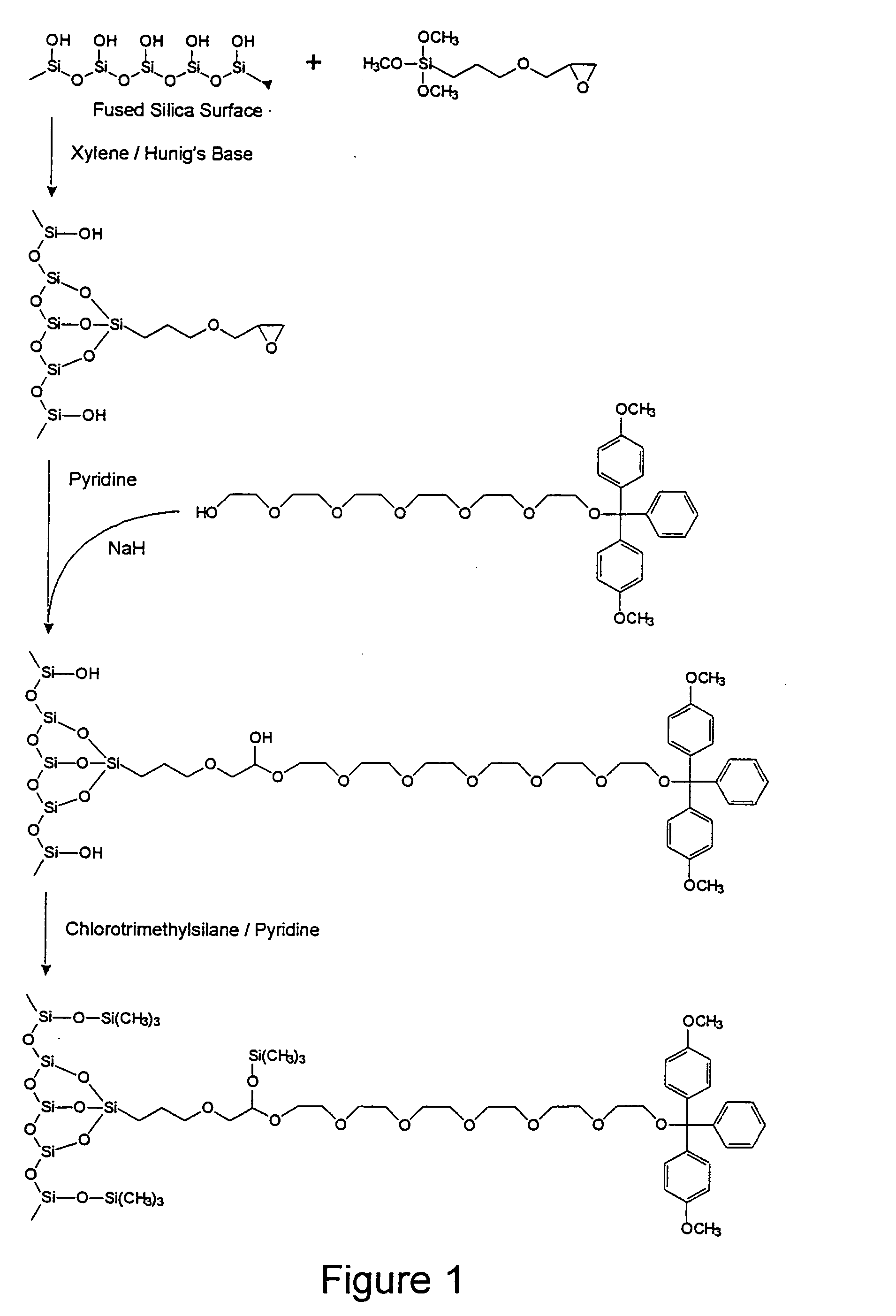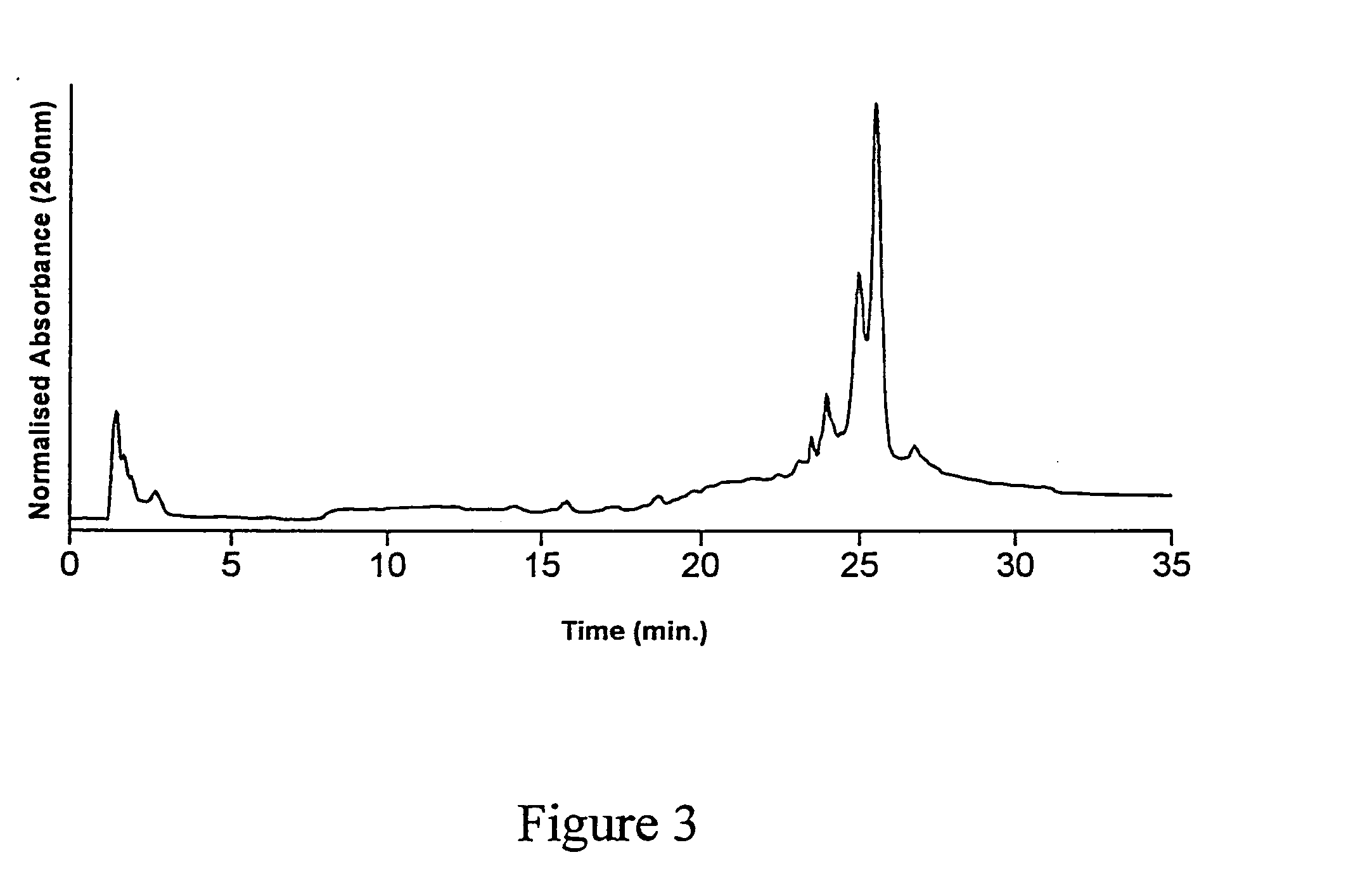Selectivity of nucleic acid diagnostic and microarray technologies by control of interfacial nucleic acid film chemistry
a technology of interfacial nucleic acid and diagnostic devices, which is applied in the direction of sugar derivatives, biochemistry apparatus and processes, and can solve the problems of complex control of the selectivity of binding and the dynamic range that can be achieved by controlling the concentration of oligonucleotide sequences at an interface, so as to increase the selectivity of nucleic acid diagnostic, increase the selectivity, and increase the selectivity
- Summary
- Abstract
- Description
- Claims
- Application Information
AI Technical Summary
Benefits of technology
Problems solved by technology
Method used
Image
Examples
example 1
Control of Oligonucleotide Immobilization Density by the GOPS-HEG
Method: Low Density Case
1.1: Chemicals.
[0099] Unless otherwise noted, all reagents for syntheses were obtained from commercial suppliers (Aldrich, Milwaukee, Wis., USA or Lancaster Synthesis Inc. Windham, N.H., USA) and were used without further purification. Unless otherwise noted, all solvents were EM Science brand (distributed by VWR Canlab, Mississauga, ON, Canada) and of reagent grade. Solvents were further purified and / or dried, when necessary, by standard distillation methods. Acetonitrile was biosynthesis grade low water from EM Science (VWR Canlab). Tetrahydrofuran (THF) was distilled from sodiumbenzophenone ketyl under argon. Dichloromethane was pre-dried by stirring with calcium chloride overnight followed by distillation over calcium chloride under argon. Acetone was distilled over calcium sulphate under argon. Nitromethane was dried over calcium chloride. Molecular biology grade salts were purchased f...
example 2
Control of Oligonucleotide Immobilization Density by the GOPS-HEG
Method: Medium Density Ease
[0112] A second batch of substrates (CPG and fused silica optical fibres) was functionalized with GOPS as described above, and underwent the DMT-HEG coupling reaction using the same reaction mixture as described in example 1, for a duration of 4 hours. The dT20-HEG conjugates were then cleaved from the surface of the CPG substrates as described in Example 1, lyophilized and redissolved in 1.000 mL water. This sample was then analyzed by AEHPLC. The resulting chromatogram is shown in FIG. 3. Quantitation of the cleaved HEG-dT20 conjugates was again achieved by co-injection with a known quantity of dT20. The peak corresponding to a retention time of 25-26 minutes was thus attributed to dT20. The results of the HPLC analysis are shown in Table 3.
TABLE 3Density of Immobilization of dT20-HEG Conjugateonto GOPS-Functionalized Substrates as Determinedby Anion-Exchange High Performance Liquid Ch...
example 3
Control of Oligonucleotide Immobilization Density by the GOPS-HEG
Method: High Density Case
[0113] A third batch of substrates (CPG and fused silica optical fibres) were functionalized with GOPS as described above, and underwent the DMT-HEG coupling reaction using the same reaction mixture as described in examples 1 and 2, for a duration of 12 hours. The dT20-HEG conjugates were then cleaved from the surface of the CPG substrates as described in Examples 1 and 2, lyophilized and redissolved in 1.000 mL water. This sample was then analyzed by AEHPLC. The resulting chromatogram is shown in FIG. 4. Quantitation of the cleaved HEG-dT20 conjugates was again achieved by co-injection with a known quantity of dT20. The peak corresponding to a retention time of 25-26 minutes was thus attributed to dT20. The results of the HPLC analysis are shown in Table 4. These data indicate that oligonucleotide immobilization density was representative of a physical environment for the immobilized oligon...
PUM
| Property | Measurement | Unit |
|---|---|---|
| Temperature | aaaaa | aaaaa |
| Time | aaaaa | aaaaa |
| Ionic strength | aaaaa | aaaaa |
Abstract
Description
Claims
Application Information
 Login to View More
Login to View More - R&D
- Intellectual Property
- Life Sciences
- Materials
- Tech Scout
- Unparalleled Data Quality
- Higher Quality Content
- 60% Fewer Hallucinations
Browse by: Latest US Patents, China's latest patents, Technical Efficacy Thesaurus, Application Domain, Technology Topic, Popular Technical Reports.
© 2025 PatSnap. All rights reserved.Legal|Privacy policy|Modern Slavery Act Transparency Statement|Sitemap|About US| Contact US: help@patsnap.com



